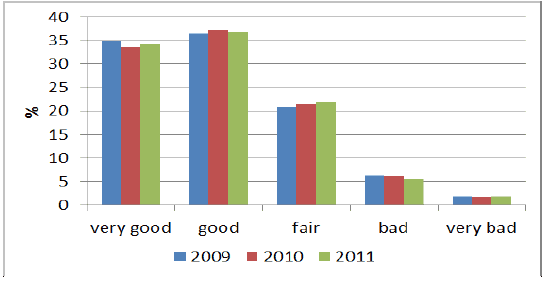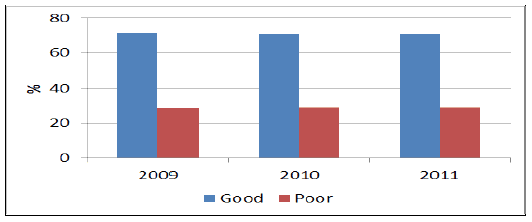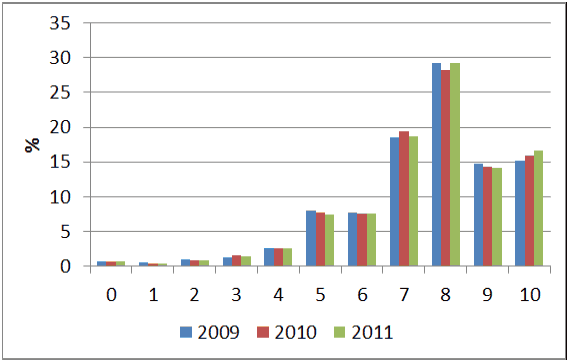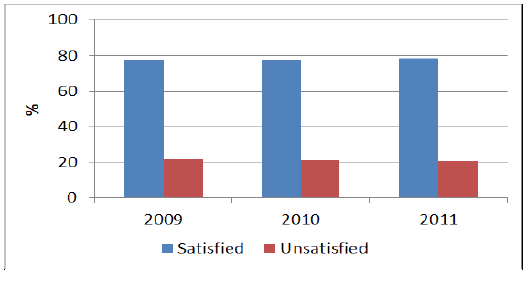Healthy Attendance? The Impact of Cultural Engagement and Sports Participation on Health and Satisfaction with Life in Scotland
Data from the Scottish Household Survey 2011 has been used to statistically explore the relationship between taking part in cultural and sporting activities, attending cultural places and key quality of life measures in Scotland. This report presents the findings of the analysis of this relationship.
3 Method
Data
3.1 The data selected for this study comes from the Scottish Household Survey (SHS) 2011. The SHS is a continuous survey based on a sample of the general population in private residences in Scotland.
3.2 The aim of the survey is to provide representative information about the composition, characteristics and behaviours of Scottish households, both at national and local authority level. The survey covers a wide range of topics to allow links to be made between different policy areas. Key functions of the SHS are:
- To enable the disaggregation of information both geographically and in terms of population sub-groups (such as families with children or the elderly);
- To examine the relationships between social variables within households and support cross-analysis on a range of issues;
- To discover early detection of national trends;
- To allow detailed follow-up surveys of sub-samples from the main survey sample, if required.
3.3 The SHS sample is selected from the small user Postcode Address File (PAF) for Scotland, expanded to take account of addresses which might only be listed once but actually contain multiple dwellings, such as tenement blocks and multi-storey flats. Due to the sampling methods based on the PAF for Scotland the sample does not completely cover the population because accommodation in hospitals, prisons, military bases, larger student halls etc. are excluded from the sampling frame.
3.4 The data used in this report is from the 2010/2011 fieldwork of the SHS. A total of 14,358 households were interviewed (response rate of 68.7%). The suite of questions on culture was asked of approximately 75% of the total sample, giving a sample size of 9683 (adults only).
3.5 Appropriate weighting was carried out before the analysis was conducted. Details on weighting are in the Technical Annex.
Dependent Variables
3.6 The two dependent variables in the analysis are self-assessed health and life satisfaction.
3.7 Self-assessed health is asked in the SHS by a standard well-tested question:
How is your health in general? Would you say it is very good, good, fair, bad or very bad?
3.8 Self-assessed health is a useful measure of how individuals regard their own overall health status. It is strongly related to the presence of chronic and acute disease, as well as being a good predictor of hospital admission and mortality.
3.9 Figure 1 shows the distribution of health status among respondents for the last three survey years. As there was relatively small numbers of respondents in the three categories of fair, bad or very bad for each of the years (28.7%, 29.2% and 29.0% collectively) the responses were dichotomized into a good health category consisting of responses 'very good/good' and a poor health category consisting of responses 'fair/poor/very poor' for use in the logistic regression analysis.
Figure 1 Distribution of Self-Assessed Health Status 2009-2011

3.10 Figure 2 shows the results using the dichotomised self-rated health variable. This dichotomised health rated variable is the dependent (outcome) variable used in the correlation and regression models. These results show that the majority of respondents view their health as good for each of the years. The proportion of those stating good health has remained stable since 2009.
Figure 2: Distribution of Self Assessed Health Dichotomised Variable

3.11 In 2009, the following question on life satisfaction was introduced in to the SHS:
All things considered, how satisfied are you with your life as a whole nowadays?
(on a scale where 0 means extremely dissatisfied and 10 means
extremely satisfied)
3.12 It should be noted that the concept of life satisfaction, or happiness, refers to a cognitive sense of satisfaction with life, and does not simply refer to an absence of negative experiences.
3.13 Figure 3 shows the distribution of life satisfaction among the respondents for each of the survey years.
Figure 3 Distribution of Life Satisfaction 2009 - 2011

3.14 As there was relatively small numbers of respondents in the lower end of the categories for each of the surveys the responses were dichotomized into a '0-6' group representing low satisfaction and a '7-10' group representing high satisfaction for use in the logistic regression analysis.
3.15 Figure 4 shows the results using the dichotomised satisfaction with life variable. This dichotomised life satisfaction variable is the dependent (outcome) variable used in the correlation and regression models. These results show that the majority of respondents (nearly 80%) report high life satisfaction; a proportion which has remained stable over the years.
Figure 4: Distribution of Life Satisfaction Dichotomised Variable

Independent Variables
Cultural Engagement
3.16 The Scottish Household Survey asks respondents two key questions on culture, one on attendance at cultural places or events and one on participation in cultural and creative activities.
3.17 Attendance at a cultural event or place of culture is defined as those people who attend at least one type of cultural place in the previous year. There are a number of different types of cultural events and places of culture listed on a showcard shown to respondents. Examples include cinemas, libraries and live music events. The complete list of cultural places or events is in the Technical Annex.
3.18 Similarly, participation in any cultural activity is defined as taking part in at least one activity in the previous year. Examples of cultural activities include reading for pleasure, dancing and crafts. The complete list of cultural and creative activities is listed in the Technical Annex.
.
3.19 Cultural engagement measures the percentage of adults who have either participated in or attended a cultural place or event during the last 12 months. This information is used to inform progress on the Scottish Government's National Indicator 41: "Increase cultural engagement".
3.20 The most recent data on cultural engagement in Scotland shows that in 2011:
- Almost nine out of ten (87%) of adults have engaged in at least one cultural activity/place/event in the previous 12 months. This includes 76% of adults attending a cultural event or place and 73% of adults participating in a cultural activity.
- The most popular cultural place to visit is the cinema with around 54% of adults visiting, while 31% of adults have attended a live music event.
- The most popular culture activity participated in is reading for pleasure, which 67% of respondents reported doing.
Participation in Sport
3.21 A broad definition of sport is used in the SHS question which includes activities such as recreational walking for more than 30 minutes. Respondents are asked if they have done any of the sports activities listed on a showcard in the previous four weeks. The full list of activities is in the Technical Annex.
3.22 The most recent data on participation in sports in Scotland shows that in 2011:
- 75% of adults stated they had participated in at least one of the activities in the list during the previous four weeks (including walking)
- When walking was excluded, just over half of adults (54%) had undertaken at least one of the remaining sports activities in the last four weeks.
- Participation was highest among those aged 16 to 44 (84%), declining steadily to only 42% of those aged 75 and over participating in any of the activities in the past four weeks.
Control Variables
3.23 The first step in selecting control variables was to consider what factors could predict ratings of health and life satisfaction other than participation in culture and sport. This stage is important as the regression analysis will tell us whether the relationship between culture and health/satisfaction with life is significant once all the other variables in the regression model have been accounted for. This analysis helps to reduce the likelihood of any significant relationship between culture and sport participation and health or satisfaction with life being due to some underlying factor that has not been accounted for.
3.24 Based on previous research (eg Scottish Government 2008; Cuypers, 2011; ONS, 2012) a number of variables were included in the analysis as control variables. These control variables include age, economic status; income; area deprivation, education qualification, disability/or long standing illness and smoking are accounted for. The variables of life satisfaction and self-assessed health were also used as independent variables for each other given the link between a person's health and their overall satisfaction with life.
3.25 Details on the control variables are included in the Technical Annex.
Analysis
3.26 The main type of analysis used in this study is regression analysis. The general purpose of regression analysis is to understand the relationship between several independent or predictor variables and a dependent (outcome) variable.
3.27 The type of regression used in this study was logistic regression which is used to identify factors that contribute to a result and also to give an indication of the relative strength of these factors. Logistic regression works on a binary output - for example the dependent variable of self-assessed health rated as poor or good (0 or 1).
3.28 The independent variables were also dichotomised where possible, or kept as categorical variables comparing the influence of each category level with a reference level. This helps to determine the odds ratio of each variable.
The odds ratio is a measure of the likelihood of an event happening to one group compared to another group. In this study we are interested in how much more likely someone is to rate their health as good or their life as satisfactory if they take part in culture or sport. Odds rations describe the strength of association between two binary variable values.
3.29 Using this technique, the study examines the relationship between dependent and independent variables in isolation, but also accounts for other factors that may explain variation in health and life satisfaction. In other words, we are able to say that any relationship found is not due to other factors accounted for, such as age, economic status; income; area deprivation, education qualification, disability/or long standing illness or smoking.
3.30 The models created using the above rationale were:
- the relationship between participating in sport and good health
- the relationship between participating in a cultural activity and good health
- the relationship between attending a cultural place or event and good health
- the relationship between participating in sport and high life satisfaction
- the relationship between participating in a cultural activity and high life satisfaction
- the relationship between attending a cultural place or event and high life satisfaction
- the relationship between individual cultural activities and good health
- the relationship between individual cultural activities and high life satisfaction
Contact
Email: Dr Niamh O'Connor
There is a problem
Thanks for your feedback